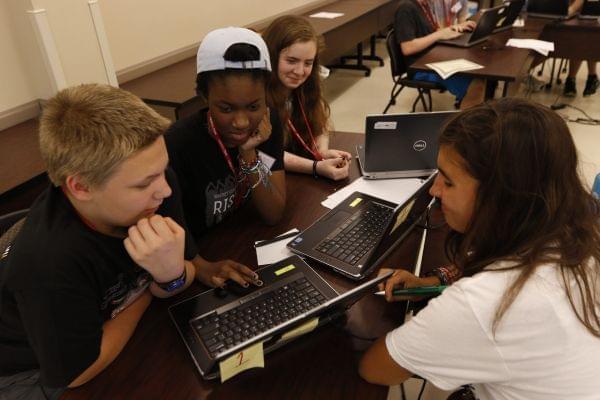Computer Science K-12 Education; Family of Stem Cell Donor Connects With Recipient 20 Years Later; Forecasting Volcanic Eruptions

Students with the Summer Program for Verbally and Mathematically Precocious Youth in Kentucky attend class. The Center For Gifted Studies WKU/Flickr(CC BY-NC 2.0)
More school districts are introducing computer science education in their classrooms. But Illinois doesn’t have any standards for teaching that subject and teachers say it’s time to come up with a clear plan. Plus, decades ago, a cutting edge stem cell treatment from umbilical cord blood saved one Illinois woman's life. And, earlier this month she met her donor and his parents for the first time. Also, we’ll talk to a University of Illinois geology professor about her work how to better forecast volcanic eruptions.
Computer Science K-12 Education
Think back to when you were a kid in school. You might remember trying to learn the basics, in topics like writing or math. Maybe as you got older you started to learn basic history and science, too.
Well, for students and teachers alike, there’s also been more and more demand for computer science education at all age levels.
And now, educators throughout the state say there’s a huge need to come up with a clear plan for K-12 computer science in Illinois. That’s because even though many districts have added computer science, there’s still a lot we don’t know about it, including a lack of established standards for K-12 public schools that teach this subject.
Raya Hegeman-Davis is the Program Coordinator for the University of Illinois’ Secondary Teacher Education and Computer Science Initiative. Bertram Ludascher is a professor at the University of Illinois’s school of information sciences and faculty affiliate at NCSA and the computer science department. Nicole Rummel is the director of instruction at the Mahomet-Seymour School District.
They are some of the participants at a summit that’s happening Friday at the University of Illinois.
"One of the misunderstandings is because it has the word 'computer' in it, these are the people who can look after your crashed PC.
— The 21st (@21stShow) September 17, 2019
It's much more about 'computational thinking'...it is really a thinking tool."
-Bertram Ludascher
Family of Stem Cell Donor Connects With Recipient 20 Years Later
In 1994, Dania Davey and her husband made an important decision. Although she didn’t quite realize how important it was at the time, that decision would save a young woman’s life hundreds of miles away.
That woman is Holly Becker, who was 24 when she received a stage 4 cancer diagnosis. Holly is an oncologist at Loyola Medicine in Maywood, Illinois decided to try a cutting edge treatment at the time in the 90's: a stem cell transplant from donated umbilical cord blood.
That cord blood came from Dania’s son Patrick. It was donated and frozen the day he was born in New York.
Holly is now cancer free. And she met the Daveys earlier this month in Illinois. It’s thought to be one of the first times a stem cell donor from umbilical cord blood has met the recipient.
Dania Davey and Holly Becker joined us. Dr. Patrick Stiff also joined us from Loyola University Medical Center. He was Holly’s oncologist back in 1997. Duke University's Dr. Joanne Kurtzberg is an expert on cord blood and director of the Carolinas Cord Blood Bank.
"It was grueling," Holly says of the procedure. "I remember feeling beyond awful and dealing with a lot of different reactions to medications."
— The 21st (@21stShow) September 17, 2019
She was in the hospital for 5 weeks but as of June 30, 1998, "we knew that it had worked."
Forecasting Volcano Eruptions
When it comes to forecasting severe weather events like hurricanes, tornadoes or earthquakes, accuracy is key. Knowing what to expect and when to expect it can mean the difference between life and death.
Now, researchers at the University of Illinois are part of a new study looking at ways we can better forecast volcanic eruptions. They’ve been studying one which happened in Alaska back in 2008, which traditional forecasting models missed.
Researchers are now using new computer models to paint a more accurate picture about if and when we can expect volcanic eruptions.
Trish Gregg, geology professor at the University of Illinois, joined us in the our Urbana studio to tell us more about the work she and her team have been doing.
Her team is looking at "little variations that are statistically valuable but that humans might miss."https://t.co/hF4gS1FTv3
— The 21st (@21stShow) September 17, 2019

